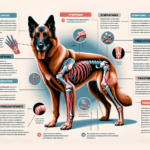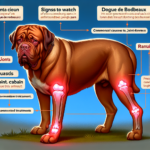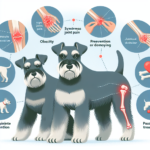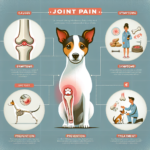American Hairless Terrier Joint Pain: Causes, Symptoms, Prevention, and Treatment
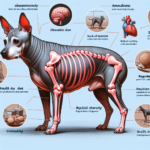
Introduction
The American Hairless Terrier (AHT) is a unique and relatively new breed that originated in the United States. Known for its lack of a coat, the AHT is a descendant of the Rat Terrier and was officially recognized by the American Kennel Club (AKC) in 2016. This breed is characterized by its energetic, intelligent, and affectionate nature, making it a popular choice for families and individuals alike. Despite its robust and active demeanor, the American Hairless Terrier, like many other breeds, is susceptible to certain health issues, including joint pain.
Joint health is a critical aspect of overall well-being for the American Hairless Terrier. Joint pain can significantly impact a dog’s quality of life, affecting their mobility, comfort, and ability to engage in daily activities. Understanding the causes, symptoms, prevention, and treatment of joint pain in this breed is essential for owners who wish to ensure their pets lead healthy and active lives.
Breed-Specific Joint Pain Risks
Genetic Predisposition
Like many breeds, the American Hairless Terrier has a genetic predisposition to certain joint-related issues. Hip dysplasia, a condition where the hip joint does not fit properly into the hip socket, is one such concern. This can lead to arthritis and significant discomfort over time. Elbow dysplasia, another genetic condition, involves abnormal development of the elbow joint, leading to pain and lameness. While these conditions are not as prevalent in AHTs as in some larger breeds, they are still a concern that owners should be aware of.
Age-Related Risks
As the American Hairless Terrier ages, the risk of developing joint pain increases. Older dogs are more prone to arthritis, a degenerative joint disease that causes inflammation and pain. For AHTs, significant age milestones to watch for include the transition from adulthood to senior years, typically around 7-8 years of age. Regular veterinary check-ups become increasingly important as the dog ages to monitor for early signs of joint issues.
Activity Level and Joint Stress
The American Hairless Terrier is an active and energetic breed, often engaging in activities such as running, jumping, and playing. While regular exercise is beneficial for overall health, excessive or high-impact activities can place stress on the joints, potentially leading to pain and injury. Owners should balance their dog’s activity level to ensure it is sufficient for maintaining health without overburdening the joints.
Common Symptoms of Joint Pain in American Hairless Terriers
General Symptoms
Owners should be vigilant for common symptoms of joint pain in their American Hairless Terrier. These symptoms include:
- Limping: A noticeable limp or favoring one leg over another.
- Stiffness: Difficulty moving, especially after resting or sleeping.
- Reluctance to Move: Hesitation or refusal to engage in activities they previously enjoyed.
- Swelling: Visible swelling around the joints.
- Whining or Crying: Vocalizing pain when moving or being touched.
Breed-Specific Symptoms
While the general symptoms of joint pain are similar across breeds, the American Hairless Terrier may exhibit some breed-specific signs. Due to their lack of fur, any swelling or inflammation around the joints may be more easily visible. Additionally, their energetic nature means that a sudden decrease in activity or enthusiasm for play can be a more noticeable indicator of discomfort.
When to Consult a Vet
If an American Hairless Terrier exhibits any of the above symptoms, it is crucial to consult a veterinarian promptly. Early diagnosis and intervention can prevent the progression of joint issues and improve the dog’s quality of life. Persistent symptoms, such as limping or reluctance to move, should not be ignored, as they may indicate a more serious underlying condition.
Preventive Measures for Joint Health
Exercise Recommendations
Regular, moderate exercise is essential for maintaining joint health in American Hairless Terriers. Activities such as walking, swimming, and gentle play are ideal for keeping the joints flexible and muscles strong without causing excessive stress. Owners should avoid high-impact activities like jumping from heights or running on hard surfaces, which can exacerbate joint issues.
Dietary Suggestions
A balanced diet rich in essential nutrients can support joint health in American Hairless Terriers. Foods containing glucosamine and chondroitin can help maintain cartilage health, while omega-3 fatty acids have anti-inflammatory properties that can reduce joint pain. Owners may also consider supplements specifically designed for joint health, but it is essential to consult a veterinarian before adding any new supplements to the dog’s diet.
Weight Management
Maintaining a healthy weight is crucial for reducing joint stress in American Hairless Terriers. Excess weight places additional pressure on the joints, exacerbating pain and increasing the risk of developing joint-related conditions. Owners should monitor their dog’s weight and adjust their diet and exercise routine as needed to ensure they remain within a healthy weight range.
Early Screening and Monitoring
Regular veterinary check-ups are vital for early detection and management of joint issues in American Hairless Terriers. Vets can perform screenings for conditions like hip and elbow dysplasia and monitor for early signs of arthritis. Early intervention can significantly improve outcomes and help manage joint pain more effectively.
Treatment Options for Joint Pain
Non-Surgical Treatments
For many American Hairless Terriers, non-surgical treatments can effectively manage joint pain. These treatments include:
- Medications: Anti-inflammatory drugs and pain relievers can reduce pain and inflammation.
- Physical Therapy: Exercises and therapies designed to improve joint function and reduce pain.
- Lifestyle Adjustments: Modifying the dog’s activity level and environment to reduce joint stress.
Surgical Options
In severe cases, surgical intervention may be necessary to alleviate joint pain in American Hairless Terriers. Common surgical options include:
- Joint Replacement: Replacing a damaged joint with an artificial one.
- Arthroscopy: A minimally invasive procedure to clean out the joint and remove damaged tissue.
- Osteotomy: Cutting and realigning bones to improve joint function.
Surgery should be considered a last resort after exploring all non-surgical options, and it is essential to consult with a veterinary specialist to determine the best course of action.
Alternative Therapies
Alternative therapies can complement traditional treatments and provide additional relief for joint pain in American Hairless Terriers. These therapies include:
- Acupuncture: Using needles to stimulate specific points on the body to reduce pain and inflammation.
- Hydrotherapy: Water-based exercises that reduce joint stress while improving strength and flexibility.
- Massage: Gentle massage techniques to improve circulation and reduce muscle tension around the joints.
Lifestyle and Management Tips
Daily Care Routine
A consistent daily care routine can help manage and alleviate joint pain in American Hairless Terriers. This routine might include:
- Regular Exercise: Short, frequent walks and low-impact activities to keep joints flexible.
- Balanced Diet: Providing a diet rich in joint-supporting nutrients.
- Weight Monitoring: Regularly checking the dog’s weight and adjusting their diet as needed.
- Medication Administration: Giving prescribed medications or supplements as directed by the vet.
Modifying the Home Environment
Making the home environment more comfortable for a dog suffering from joint pain can significantly improve their quality of life. Consider the following modifications:
- Ramps: Installing ramps to help the dog navigate stairs or get onto furniture without jumping.
- Orthopedic Beds: Providing supportive bedding to reduce pressure on the joints.
- Non-Slip Flooring: Using rugs or mats to prevent slipping on hard floors.
Long-Term Management
Long-term management of joint pain in American Hairless Terriers involves ongoing monitoring and adjustments to their care routine. Regular veterinary check-ups, maintaining a healthy weight, and providing appropriate exercise and nutrition are key components of long-term management. Owners should also be prepared to adapt their dog’s routine as their condition changes over time.
FAQs About American Hairless Terriers and Joint Pain
What are the early signs of joint pain in American Hairless Terriers?
Early signs of joint pain include limping, stiffness, reluctance to move, and visible swelling around the joints. Owners should also watch for changes in behavior, such as decreased activity levels or vocalizing pain when moving.
Can joint pain in American Hairless Terriers be prevented?
While it may not be possible to prevent all cases of joint pain, owners can take steps to reduce the risk. This includes providing a balanced diet, maintaining a healthy weight, ensuring regular, moderate exercise, and scheduling regular veterinary check-ups for early detection and intervention.
Are there specific exercises that are better for American Hairless Terriers with joint pain?
Low-impact exercises such as walking, swimming, and gentle play are ideal for American Hairless Terriers with joint pain. These activities help maintain joint flexibility and muscle strength without causing excessive stress on the joints.
What dietary supplements can help with joint health in American Hairless Terriers?
Supplements containing glucosamine, chondroitin, and omega-3 fatty acids can support joint health. However, it is essential to consult a veterinarian before adding any new supplements to the dog’s diet to ensure they are appropriate and safe.
When should I consider surgery for my American Hairless Terrier’s joint pain?
Surgery should be considered when non-surgical treatments are no longer effective in managing the dog’s pain and mobility. A veterinary specialist can help determine the best course of action based on the severity of the condition and the dog’s overall health.
Conclusion
Joint pain is a significant concern for American Hairless Terriers, impacting their mobility and quality of life. By understanding the causes, symptoms, prevention, and treatment options, owners can take proactive steps to ensure their pets remain healthy and active. Regular veterinary check-ups, a balanced diet, appropriate exercise, and weight management are crucial components of joint health. Early detection and intervention can make a significant difference in managing joint pain and improving the overall well-being of American Hairless Terriers. Owners should consult their veterinarian regularly to develop a comprehensive care plan tailored to their dog’s specific needs.

